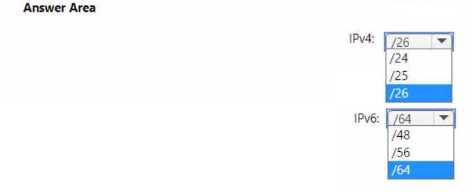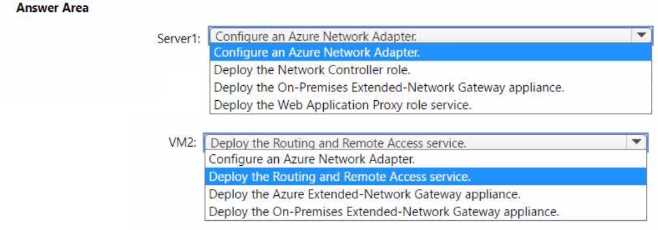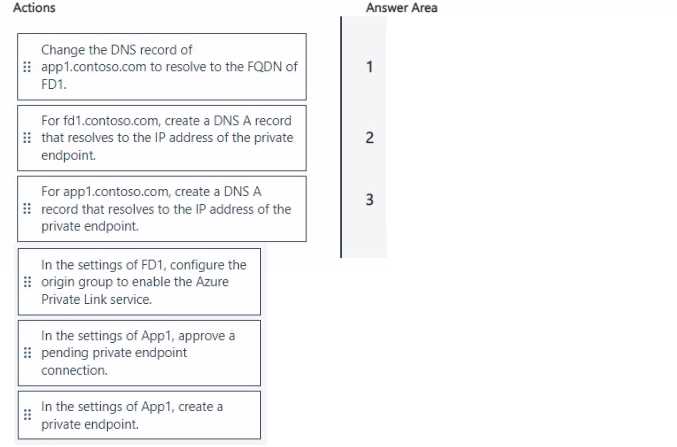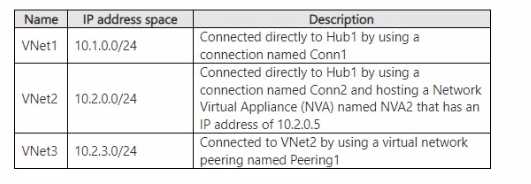What is the Microsoft AZ-700 exam, and what will you learn from it?
The Microsoft Azure AZ-700 exam, also known as Designing and Implementing Microsoft Azure Networking Solutions, is designed for networking professionals, cloud engineers, and IT administrators who want to validate their skills in designing, implementing, and managing Azure networking solutions.
By preparing for and passing the AZ-700 exam, you will gain expertise in Azure networking architecture, hybrid connectivity, routing, security, load balancing, and monitoring.
This certification demonstrates your ability to build scalable, secure, and highly available network solutions in Azure. Practicing with the best AZ-700 exam questions at Cert Empire ensures you are prepared for real-world scenario-based questions.
Exam Snapshot
|
Exam Detail
|
Description
|
|
Exam Code
|
AZ-700
|
|
Exam Name
|
Designing and Implementing Microsoft Azure Networking Solutions
|
|
Vendor
|
Microsoft
|
|
Version / Year
|
2025
|
|
Average Salary
|
$100,000 – $140,000 annually (varies by region and experience)
|
|
Cost
|
$165 USD
|
|
Exam Format
|
Multiple-choice, scenario-based, and practical networking tasks
|
|
Duration (minutes)
|
120 minutes
|
|
Delivery Method
|
Online proctored or testing center
|
|
Languages
|
English, plus additional languages
|
|
Scoring Method
|
Weighted scoring (0–1000 points)
|
|
Passing Score
|
700/1000
|
|
Prerequisites
|
Recommended: AZ-900 and AZ-104, experience with networking in Azure
|
|
Retake Policy
|
Wait 24 hours after first attempt; limited attempts in a year
|
|
Target Audience
|
Network engineers, cloud engineers, and Azure administrators
|
|
Certification Validity
|
1 year
|
|
Release Date
|
2021
|
Prerequisites before taking the AZ-700 exam
Candidates should ideally have:
- Hands-on experience with Azure networking services including VNets, VPNs, Azure Firewall, and ExpressRoute.
- Understanding of routing, load balancing, and hybrid connectivity.
- Familiarity with security, monitoring, and network troubleshooting tools in Azure.
- Basic knowledge of cloud concepts and Azure administration (AZ-900 and AZ-104 recommended).
Main objectives and domains you will study for AZ-700
The AZ-700 exam focuses on designing and implementing Azure networking solutions. The main domains include:
- Design, Implement, and Manage Hybrid Networking (15–20%) – VPNs, ExpressRoute, and private connectivity.
- Design and Implement Core Networking Infrastructure (25–30%) – Virtual networks, subnets, peering, and IP addressing.
- Design and Implement Routing and Connectivity (20–25%) – Route tables, BGP, and network security groups.
- Design and Implement Secure Network Solutions (15–20%) – Azure Firewall, DDoS protection, and network segmentation.
- Monitor, Troubleshoot, and Optimize Network Solutions (10–15%) – Monitoring, diagnostics, and optimization.
Topics to cover in each AZ-700 exam domain
Design, Implement, and Manage Hybrid Networking:
- Implement site-to-site, point-to-site, and ExpressRoute connections
- Configure private and hybrid network connectivity
- Design for high availability and failover
Design and Implement Core Networking Infrastructure:
- Create and manage VNets, subnets, and peering
- Configure IP addressing, DNS, and load balancing
- Implement virtual network gateways and service endpoints
Design and Implement Routing and Connectivity:
- Configure route tables and BGP
- Implement network traffic routing and segmentation
- Manage connectivity across VNets and subscriptions
Design and Implement Secure Network Solutions:
- Implement Azure Firewall, DDoS protection, and NSGs
- Secure hybrid networks with conditional access and encryption
- Apply network segmentation and security best practices
Monitor, Troubleshoot, and Optimize Network Solutions:
- Use Azure Monitor, Network Watcher, and Traffic Analytics
- Diagnose connectivity and performance issues
- Optimize network traffic, latency, and cost
Changes in the latest version of AZ-700
The latest AZ-700 exam emphasizes hybrid cloud networking, advanced security, and monitoring, including updates for Azure Virtual WAN, Firewall Manager, and DDoS protection. Candidates are expected to implement modern networking solutions that reflect real-world enterprise environments.
Register and schedule your AZ-700 exam
You can register through the Microsoft Certification portal. Exams are available online with a proctor or at authorized testing centers.
AZ-700 exam cost, and can you get any discounts?
The exam costs $165 USD. Discounts may be available for students, educators, or Microsoft Learn partners. Bundled study materials and practice questions from Cert Empire can help reduce costs and enhance preparation.
Exam policies you should know before taking AZ-700
- Present a valid government-issued ID.
- Arrive or log in 30 minutes early.
- Electronic devices, notes, and calculators are prohibited during the exam.
- Review retake policies if an attempt is unsuccessful.
What can you expect on your AZ-700 exam day?
- Scenario-based multiple-choice and practical networking tasks.
- Questions covering hybrid connectivity, routing, security, and monitoring.
- 120 minutes to complete all exam questions.
Practicing with the best AZ-700 exam questions at Cert Empire ensures you are confident with real-world Azure networking scenarios.
Plan your AZ-700 study schedule effectively with 5 Study Tips
Tip 1: Review the official AZ-700 exam blueprint thoroughly.
Tip 2: Set up hands-on labs for VNets, VPNs, ExpressRoute, and Azure Firewall.
Tip 3: Practice with curated exam questions to identify knowledge gaps.
Tip 4: Join Azure networking forums or study groups for scenario discussions.
Tip 5: Take timed mock exams to simulate real exam conditions and improve pacing.
Best study resources you can use to prepare for AZ-700
- Microsoft Learn: AZ-700 learning paths and labs
- Azure free tier for practical networking exercises
- Cert Empire’s curated AZ-700 practice questions
- Video tutorials from Microsoft and trusted online platforms
- Networking forums and Azure community groups
Career opportunities you can explore after earning AZ-700
- Azure Network Engineer – designing, implementing, and managing Azure networking solutions.
- Cloud Network Architect – planning hybrid and enterprise-scale networking.
- Azure Administrator – monitoring and troubleshooting network solutions.
- Security Engineer (Networking focus) – securing cloud networks with best practices.
AZ-700 certification demonstrates your ability to design and implement secure, scalable, and reliable network solutions in Azure, opening advanced career opportunities in cloud networking.
Certifications to go for after completing AZ-700
- AZ-305: Azure Solutions Architect Expert
- AZ-500: Azure Security Engineer Associate
- AZ-104: Azure Administrator Associate (if not already completed)
These certifications build on AZ-700 skills and prepare professionals for advanced cloud architecture, security, and administration roles.
How does AZ-700 compare to other beginner-level cloud certifications?
AZ-700 is a specialized, intermediate-level certification focusing on networking, unlike AZ-900 (fundamentals) or AZ-104 (administration). It is comparable to AWS Advanced Networking Specialty or Google Professional Cloud Network Engineer, targeting professionals responsible for enterprise cloud networking.
Practicing with the best AZ-700 exam questions at Cert Empire ensures you gain hands-on networking experience, understand scenario-based questions, and confidently pass the exam while mastering real-world Azure networking solutions.


 You need to ensure that on-premises devices can communicate with Azure resources that are connected to Subnet4. What should you do on each resource? To answer, select the appropriate options in the answer area. NOTE: Each correct selection is worth one point.
You need to ensure that on-premises devices can communicate with Azure resources that are connected to Subnet4. What should you do on each resource? To answer, select the appropriate options in the answer area. NOTE: Each correct selection is worth one point. 
 You plan to deploy an app named App1 to meet the following requirements. • External users must be able to access App1 from the internet. • App1 will be load balanced across all the virtual machines. • App1 will be hosted on VM1, VM2. VM3. and VM4. • App1 must be available if an Azure region fails. • Costs must be minimized. You need to implement a global load balancer solution for App. What should you configure? To answer, select the appropriate options in the answer area NOTE: Bach correct answer is worth one point.
You plan to deploy an app named App1 to meet the following requirements. • External users must be able to access App1 from the internet. • App1 will be load balanced across all the virtual machines. • App1 will be hosted on VM1, VM2. VM3. and VM4. • App1 must be available if an Azure region fails. • Costs must be minimized. You need to implement a global load balancer solution for App. What should you configure? To answer, select the appropriate options in the answer area NOTE: Bach correct answer is worth one point. 
 You need to implement an Azure application gateway named AG1 that will be integrated with an
Azure Web Application Firewall (WAF). AG1 will be used to publish VMSS1.
To which subnet should you connect AG1?
You need to implement an Azure application gateway named AG1 that will be integrated with an
Azure Web Application Firewall (WAF). AG1 will be used to publish VMSS1.
To which subnet should you connect AG1?
 Each virtual network contains 20 internet-accessible resources that are assigned public IP addresses.
You need to implement Azure DDoS Network Protection to protect the resources. The solution must
minimize costs.
What is the minimum number of DDoS Network Protection plans you should deploy?
Each virtual network contains 20 internet-accessible resources that are assigned public IP addresses.
You need to implement Azure DDoS Network Protection to protect the resources. The solution must
minimize costs.
What is the minimum number of DDoS Network Protection plans you should deploy? You need to ensure that hosts connected to VNet1 can communicate with hosts connected to VNet3. How should you configure the routing tables for VWAN1? To answer, select the appropriate options in the answer area. NOTE: Each correct selection is worth one point.
You need to ensure that hosts connected to VNet1 can communicate with hosts connected to VNet3. How should you configure the routing tables for VWAN1? To answer, select the appropriate options in the answer area. NOTE: Each correct selection is worth one point. 



Victoria (verified owner) –
Thank you.
Leif (verified owner) –
The practice guide had scenario-based exercises that felt like real networking cases. They helped me connect the theory to real-world problem-solving, making studying more engaging and practical for the exam.